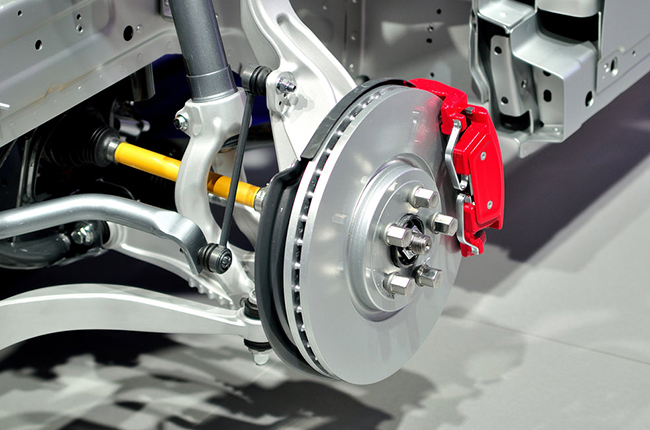
Brakes have been putting a stop to anything that has wheels for decades, and they’ve come a long way from the early attempts to create more powerful stopping solutions for vehicles that were getting progressively faster. Braking systems have been continuously getting better over the years, and with more lightweight and sturdy components, have been responsible for putting a halt to small economy cars and high performance supercars.
In today’s modern cars, chances are you are aware of the two different types of braking systems used in automotive manufacturing and development – drum and disc brakes. Some cars use a combination of the two, and some use discs exclusively. Now, before we dive into the characteristics of each, let’s talk about the idea behind brakes.
A braking system is designed to slow down and stop a vehicle by using two principles – friction and heat. Friction is applied to a turning wheel by a braking system, slowing it down and eventually allowing it to come to a stop. Heat is a byproduct of this friction. Of course, factors such as vehicle weight, amount of braking force, and braking surface area affect the rate at which the slowdown occurs. The more braking force applied, the more friction is generated against the wheel, and the more heat needs to dissipate in order for the braking system to perform at its best.
Drum Brakes

Considered one of the earliest braking systems, drum brakes are made up of components that are housed in a round drum that rotated with the wheel. Inside this housing was a set of expandable, heat resistant shoes that would press against the edges of the drum when the pedal was pressed. The friction would slow down and stop the wheel from turning. This method used fluid in a closed hydraulic system to transfer the movement of the pedal to the brake shoes.
Generally, it was a perfectly acceptable design that had one main weakness – brake fade due to heat. Drum brakes have a low tolerance for absorbing the heat generated from braking, especially when you’ve been going downhill with a heavy load or taking a number of turns with high-speed slowdowns. Once the drum brakes reach their limit of heat, they suddenly lose the ability to slow down or stop the vehicle effectively.
Disc Brakes

Following the same principles of friction and heat, disc brakes have been found to be far superior to drum brakes. Instead of housing components in a drum, an exposed rotor and caliper are used to halt wheel movement. Inside the caliper are two brake pads in each side of the rotor, and these clamp together when the brake pedal is depressed, effectively applying friction on either side of the brake rotor. This is also a closed hydraulic system, and the fluid takes care of actuating the calipers based on the brake pedal.
Since the components are exposed to open air, it is constantly cooled when the vehicle is moving, reducing the tendency to overheat or cause brake fade. Credit racers and track cars for this technology, as the high demands of racing have shown the advantages of discs over drums, allowing those with disc brakes to brake later and harder.
Disc Brake and Drum Brake Combinations
You’ll also notice that some vehicles on sale today are still equipped with drum brakes at the rear wheels and disc brakes at the front. While some will say that this is a form of cost-cutting or cheaping-out by manufacturers, the truth is that both braking technologies have been constantly evolving and improving, outperforming standards set decades ago. Add to the fact that majority of a vehicle’s stopping power comes from the front wheels, the drums at the rear are just picking up the slack, making today’s disc and drum combinations completely adequate for a majority of road going cars.

Of course, for high performance vehicles, a four-wheel disc setup is completely justifiable, as the speeds are much higher, the brakes are used harder, and the heat generated from slowing down at high speeds is greater. These vehicles come with a much higher ownership cost, so you can expect some over-engineering from their braking systems. If your normal road going car comes with disc brakes all around, then good on you, as your manufacturer has found a way to figure its cost into its price, leading to superior braking performance over disc and drum combos.
Latest Features
-
How to prepare your car for the Holidays / Featured Article
Here are our handy tips on how to keep you on the road and stress free this holiday season.
-
An all-electric future: The Porsche Macan Electric / Featured Article
Porsche’s Macan goes all-electric; it’s a new beast with an electrified heart, yet unmistakably Porsche in performance and spirit.
-
Which Kia should I buy? / Featured Article
We’re here to help you decide which Kia vehicle is best for you, whether it’s a sedan, crossover, or minivan.
Popular Articles
-
Electric Vehicles in the Philippines for under P1 million
Jerome Tresvalles · Aug 19, 2025
-
Top 3 Cars For Every Lifestyle—What Cars Are Right For You? | Behind a Desk
Caco Tirona · Apr 24, 2024
-
5 Tips to Maximize Fuel Efficiency
Jerome Tresvalles · Sep 09, 2024
-
Five driving habits that are draining your fuel tank
Jerome Tresvalles · Jun 24, 2025
-
Can engine braking harm your engine?
Jerome Tresvalles · Sep 11, 2025
-
Do electric cars even need maintenance?
Jerome Tresvalles · Oct 23, 2024
-
Best vehicles for an active outdoor lifestyle
Shaynah Miranda · Jul 25, 2024
-
How to drive different types of vehicle transmissions
May 23, 2024
-
5 easy ways to keep your car interior clean
Allysa Mae Zulueta · Nov 15, 2021
-
How to survive Metro Manila traffic
Earl Lee · Aug 16, 2022



